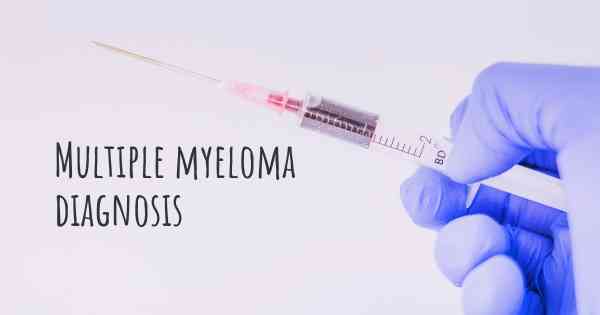How is Multiple myeloma diagnosed?
See how Multiple myeloma is diagnosed. Which specialists are essential to meet, what tests are needed and other useful information for the diagnosis of Multiple myeloma

Diagnosis of Multiple Myeloma
Multiple myeloma is a type of cancer that affects plasma cells, which are a crucial part of the immune system. Diagnosing multiple myeloma involves a series of tests and evaluations to confirm the presence of the disease. Early detection is essential for effective treatment and management of the condition.
Medical History and Physical Examination
When a patient presents with symptoms that may indicate multiple myeloma, the first step in the diagnostic process is a comprehensive medical history and physical examination. The doctor will inquire about the patient's symptoms, medical history, and any relevant risk factors. During the physical examination, the doctor will assess for signs such as bone tenderness, swelling, or other abnormalities.
Blood and Urine Tests
Several laboratory tests are used to aid in the diagnosis of multiple myeloma. Blood tests are commonly performed to measure various markers and evaluate the overall health of the patient. The complete blood count (CBC) provides information about the number and types of blood cells, while a blood chemistry panel assesses organ function and electrolyte levels.
In addition to blood tests, urine tests are crucial in diagnosing multiple myeloma. A urine protein electrophoresis (UPEP) test is performed to detect abnormal proteins, known as M proteins, which are produced by myeloma cells. The presence of M proteins in the urine can be indicative of multiple myeloma.
Bone Marrow Biopsy
A bone marrow biopsy is a key diagnostic procedure for multiple myeloma. It involves the extraction of a small sample of bone marrow, typically from the hip bone, using a needle. The procedure is performed under local anesthesia. The collected sample is then examined under a microscope to assess the presence of myeloma cells and determine their characteristics.
Imaging Tests
Imaging tests are essential to evaluate the extent of the disease and identify any bone abnormalities associated with multiple myeloma. X-rays are commonly used to detect bone damage, such as fractures or lesions. However, in more advanced cases, additional imaging techniques may be employed, including magnetic resonance imaging (MRI) or computed tomography (CT) scans. These tests provide detailed images of the bones, allowing doctors to assess the extent of bone involvement.
Additional Tests
In some cases, additional tests may be necessary to confirm the diagnosis and gather more information about the disease. These tests may include:
- Flow cytometry: This test helps identify specific markers on the surface of myeloma cells, aiding in their characterization.
- Genetic testing: Certain genetic abnormalities, such as translocations or mutations, can be detected through specialized tests, providing valuable information for treatment planning.
- Serum protein electrophoresis (SPEP): Similar to UPEP, this blood test detects abnormal proteins in the blood, helping to confirm the diagnosis.
- Immunofixation electrophoresis (IFE): This test is used to determine the specific type of abnormal protein present in the blood or urine.
Consultation with a Hematologist-Oncologist
Once the diagnostic tests are completed, the results are reviewed by a hematologist-oncologist, a specialist in blood disorders and cancer. The hematologist-oncologist will analyze the findings, consider the patient's symptoms and medical history, and make a definitive diagnosis of multiple myeloma.
Conclusion
Diagnosing multiple myeloma involves a combination of medical history evaluation, physical examination, blood and urine tests, bone marrow biopsy, imaging tests, and potentially additional specialized tests. The collaboration between various healthcare professionals, including primary care physicians, hematologists, and radiologists, is crucial in accurately diagnosing multiple myeloma. Early diagnosis enables prompt initiation of appropriate treatment strategies, improving the chances of successful management and improved patient outcomes.
Posted Jul 19, 2017 by Larry 2100
Posted Jul 19, 2017 by Deb 2000
Posted Jul 20, 2017 by Tammy Gallet Ward 2000








